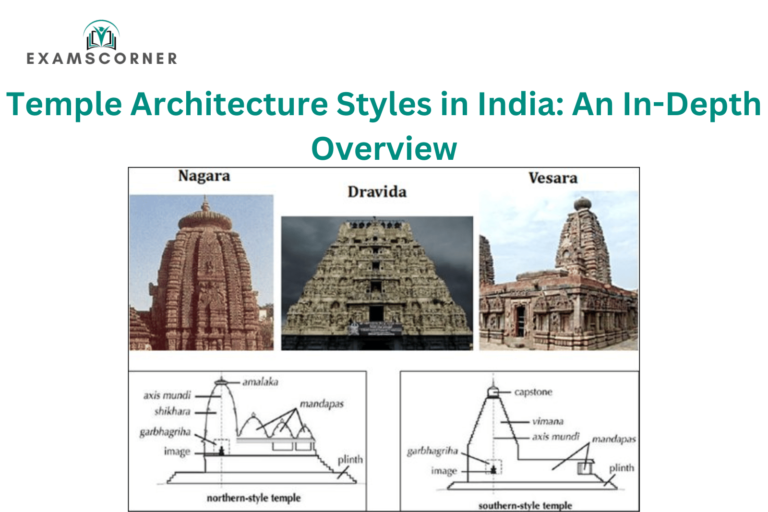Indian temple architecture reflects the country’s rich cultural and historical legacy. The Shilpashastras (architectural texts) of the early medieval period categorize temple architecture into three primary styles: Nagara, Dravida, and Vesara. These styles, rooted in regional, cultural, and religious influences, stand as timeless symbols of architectural brilliance.
Three Major Temple Architecture Styles
1. Nagara Style
Origin: North India (region between the Himalayas and the Vindhyas)
Development: Emerged during the Gupta period
Key Features
- Shikhar: The towering topmost structure represents Mount Meru, a sacred cosmic mountain in Hindu mythology.
- Garbha Griha: The inner sanctum, a small chamber for personal communion with the deity.
- Antaral: Vestibule connecting the Garbha Griha to the Mandap.
- Kalash: A symbolic water pot placed atop the Shikhar, signifying fertility, birth, and productivity.
- Mandaps: Assembly halls, such as Maha Mandap, Mandap, and Ardh Mandap, although relatively smaller than their southern counterparts.
Notable Examples
- Lingaraja Temple (Bhubaneswar) – 11th century
- Kandariya Mahadeva Temple (Khajuraho)
2. Dravida Style
Origin: South India
Development: Dates back to the Gupta period
Key Features
- Extensive Use of Pillars: Pillars and pilasters are a hallmark of this style.
- Shikhar Design: Features a slightly curved tower with pyramidal elevation, consisting of progressively smaller stories.
- Gopurams: Monumental gateways, a later addition to this style.
- Boundary Walls: Dravidian temples are enclosed by boundary walls, unlike their Nagara counterparts.
Notable Examples
- Brihadeeswarar Temple (Thanjavur)
- Kailasanatha Temple (Kanchipuram)
3. Vesara Style
Origin: Karnataka region
Development: Evolved during the early medieval period under the Chalukya dynasty
Key Features
- Hybrid Architecture: Combines elements of Nagara and Dravida styles.
- Shikhar Design: Resembles a pagoda, with a slightly reduced height compared to Nagara temples.
- Emphasizes intricate carvings and artistic balance.
Notable Examples
- Papanatha Temple (Pattadakal)
- Hoysala Temples (Belur, Halebidu, and Somnathpura)
Common Characteristics of Indian Temple Architecture
- Platform Foundation: Temples are built on raised platforms with expansive layouts.
- Elaborate Carvings: Each style showcases intricate carvings reflecting local artistry.
- Development Stages:
- Initial Stage: Simple pillars and structures.
- Second Stage: Addition of carvings and enhanced structural weight.
- Third Stage: Extensive decorations on Shikhar and pillars.
Significance of Temples in Ancient India
- Religious and Cultural Centers: Temples symbolized devotion and provided a space for worship.
- Social Institutions: Functioned as banks, shelters for the destitute, and community hubs.
- Employment Generators: Created opportunities for singing, dancing, cooking, garland-making, and more.
- Economic Catalysts: In regions facing agricultural challenges, temple construction provided employment and revitalized local economies.
- Aesthetic Marvels: Testify to the craftsmanship and creativity of ancient Indian artisans.
Conclusion
Indian temple architecture represents a harmonious blend of artistic expression, religious devotion, and social significance. Whether it’s the towering Shikhars of the Nagara style, the grand Gopurams of the Dravida style, or the balanced beauty of the Vesara style, these architectural wonders remain unparalleled.
As custodians of history, it’s essential to preserve and celebrate these architectural gems that continue to inspire awe and reverence across the globe.



